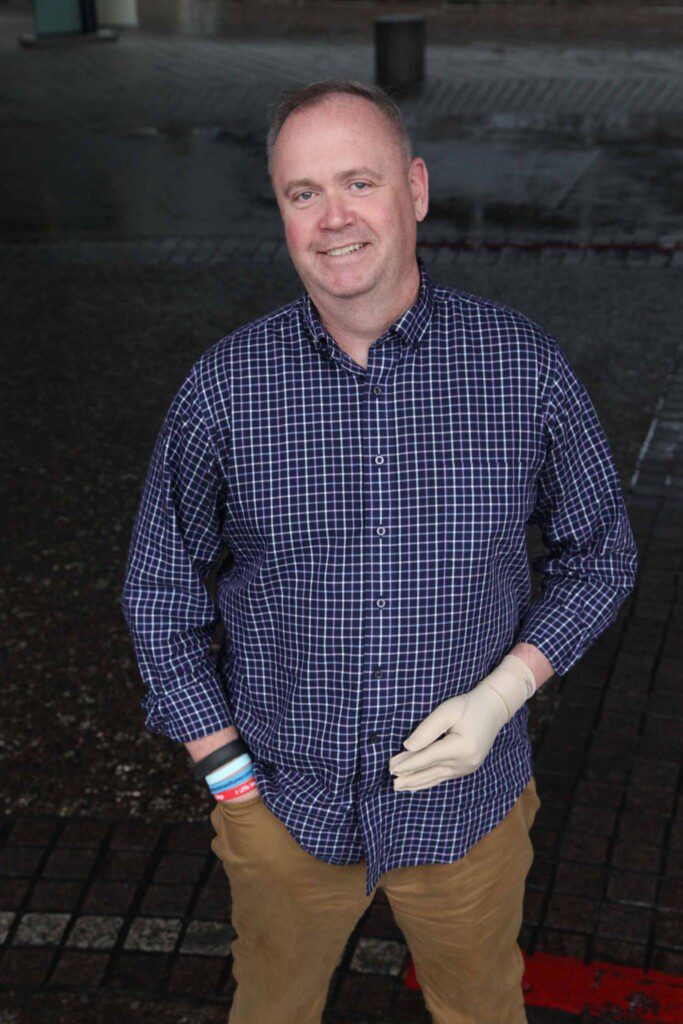Written by Ross McCreery for the RSDSA blog.
 How and when did you develop CRPS/RSD?
How and when did you develop CRPS/RSD?
In 2005 I had a surgery to remove a cyst from my left wrist. Immediately after the surgery my entire arm started to swell right to my shoulder, and I started suffering from intense burning pain. My entire arm changed color and eventually I lost function of my hand. The search was on to find a diagnosis yet nobody was able to. In 2006 after exhausting all the resources available in the city that I live in, I ended up flying to another city (Vancouver) where a specialist in chronic pain made the official diagnosis. Shortly after diagnosis CRPS spread to my left leg after tearing tendons in that the ankle.
What has daily life been like since your diagnosis?
Daily life has been difficult at times because from one day to the next I never know what my pain is going to be like. No longer able to work, over the first few years I had to figure out ways to adapt basic life skills. It has become a full time job to manage my pain or deal with how this all affects my mental health. To do this, I have a toolbox of different ways in which to manage all of these things. The other big adjustment has been in how our family functions. Everything always has to be planned around me! Meaning that things like daily routines, family gatherings, and vacations all hinge on how I am doing. Now I do o’t want to be all doom and gloom. As time’s gone by, some aspects have become easier to navigate in living with CRPS/RSD. I do not have to rely on others as much as I used to, and I have gained a large portion of my independence back.
What is one thing you wish those without CRPS/RSD could understand?
I really wish people without CRPS/RSD could understand the complexity of CRPS/RSD. There are days where I feel somewhat normal, and others where I am rocking in the fetal position because the pain and burning get so bad. So please do not judge me and say that I am faking it or that it is all in my head, just because from one day to the next I might appear very different. You need to understand that there’s a lot going on inside my body that you just do not see.
What advice would you give to newly diagnosed Warriors?
The most important piece of advice I could give a newly diagnosed warrior is this. Never lose hope! So many newly diagnosed warriors give up, or think that once they have been diagnosed that there is “no life after diagnosis” but nothing could be further from the truth. I try to tell those who are newly diagnosed to keep riding out the storm. Eventually the seas will calm allowing you to gain control. You “WILL” survive this storm! Find a support group or others living will CRPS whether it be online or in person. You are going to need them to encourage you on those hard days. No matter how difficult your journey is going to be, you can still live a crazy ridiculously good life!
What advice would you give to Warriors who have had CRPS/RSD for many years?
My advice for someone living with CRPS/RSD would also be to never lose hope and be positive! Take a look at your situation and ask yourself are you stuck? When we live with CRPS/RSD for many years we can get lost in quite literally a world of pain. This can cause you to get “stuck in a rut” because you are tired of having tried everything imaginable. The natural response is to give up and want to wave the white flag in surrender. My response to that is to say to you “keep trying” and never give in to this disease! Strive to overcome and if you are in a good place with your CRPS/RSD then speak into another person’s life and help support them.
What activities or treatments have helped you find temporary or long term relief?
The difficulty with CRPS is that what works for one person may not necessarily work for the other. So it becomes this matter of finding the right mix of activities or treatments that works for each of us! This has meant that I have had to build a personalized treatment plan for myself through my care team. A combination of drug therapy (Ketamine Infusions & daily meds) along with two neuro-stimulators that were implanted has given me the most effective pain relief. I have also incorporated the use of biofeedback on a daily basis into my daily routine. I have radically changed my diet and gone to almost entirely a plant base diet with lots of foods high in anti-inflammatory properties. This helps to control some of my swelling in both my affected arm and leg. These are only a few of the many strategies that I use.
Anything else you would like to add?
I really believe that it takes a well rounded approach in order to achieve long term relief.
In my own journey this means looking at and then either incorporating or making changes to six different areas. Those are within the areas of lifestyle, psychological, physical therapy, interventional therapies, spirituality, and medications. For myself I have made changes in the following areas:
- Lifestyle – Changes to my diet, stress management, and getting into a hobby
- Psychological – Biofeedback, Mindfulness, support groups, and counseling
- Physical Therapy – Physical Therapy
- Interventional Therapies – Injections, and having the neuro-stimulator implanted
- Spirituality – Prayer
- Medications – daily medications and Ketamine Infusions
